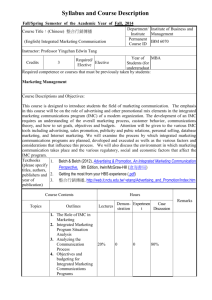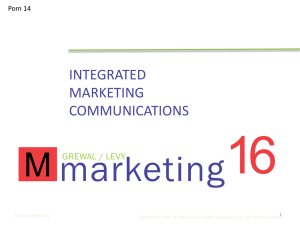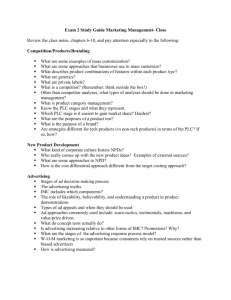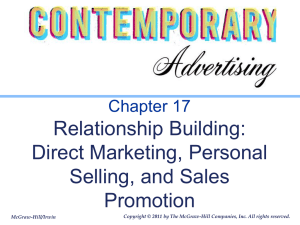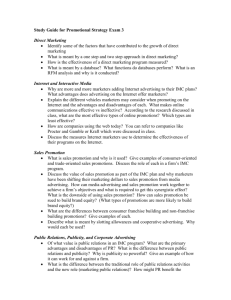the new marketing, imc and the role of online promotion
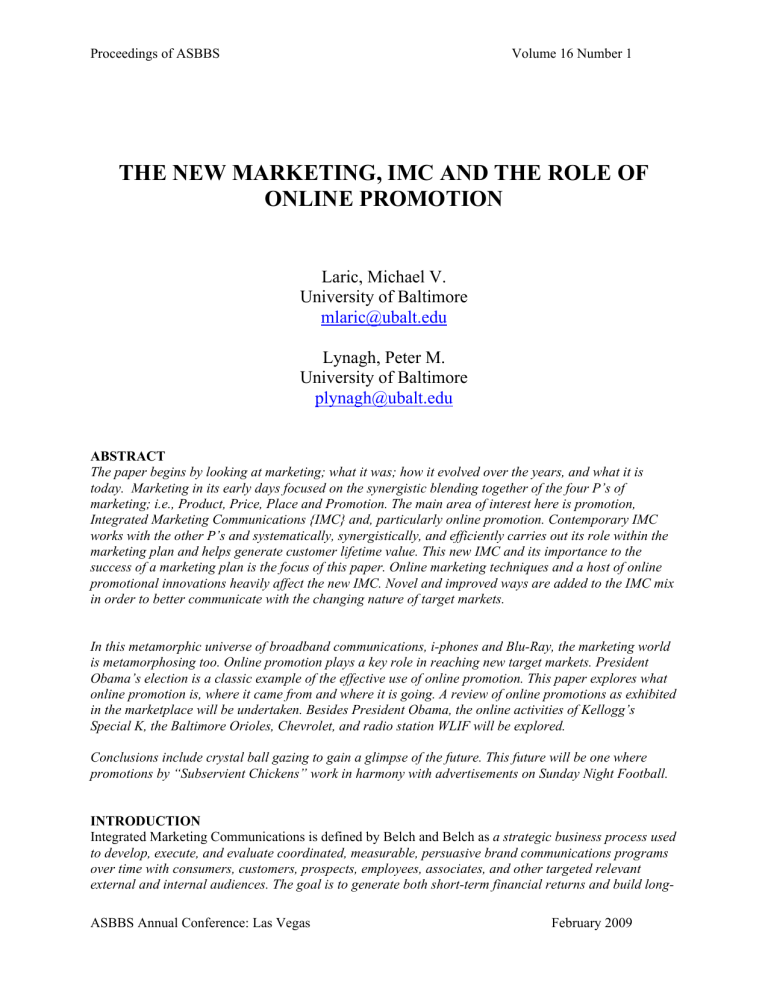
Proceedings of ASBBS Volume 16 Number 1
THE NEW MARKETING, IMC AND THE ROLE OF
ONLINE PROMOTION
Laric, Michael V.
University of Baltimore mlaric@ubalt.edu
Lynagh, Peter M.
University of Baltimore plynagh@ubalt.edu
ABSTRACT
The paper begins by looking at marketing; what it was; how it evolved over the years, and what it is today. Marketing in its early days focused on the synergistic blending together of the four P’s of marketing; i.e., Product, Price, Place and Promotion. The main area of interest here is promotion,
Integrated Marketing Communications {IMC} and, particularly online promotion. Contemporary IMC works with the other P’s and systematically, synergistically, and efficiently carries out its role within the marketing plan and helps generate customer lifetime value. This new IMC and its importance to the success of a marketing plan is the focus of this paper. Online marketing techniques and a host of online promotional innovations heavily affect the new IMC. Novel and improved ways are added to the IMC mix in order to better communicate with the changing nature of target markets.
In this metamorphic universe of broadband communications, i-phones and Blu-Ray, the marketing world is metamorphosing too. Online promotion plays a key role in reaching new target markets. President
Obama’s election is a classic example of the effective use of online promotion. This paper explores what online promotion is, where it came from and where it is going. A review of online promotions as exhibited in the marketplace will be undertaken. Besides President Obama, the online activities of Kellogg’s
Special K, the Baltimore Orioles, Chevrolet, and radio station WLIF will be explored.
Conclusions include crystal ball gazing to gain a glimpse of the future. This future will be one where promotions by “Subservient Chickens” work in harmony with advertisements on Sunday Night Football.
INTRODUCTION
Integrated Marketing Communications is defined by Belch and Belch as a strategic business process used to develop, execute, and evaluate coordinated, measurable, persuasive brand communications programs over time with consumers, customers, prospects, employees, associates, and other targeted relevant external and internal audiences. The goal is to generate both short-term financial returns and build long-
ASBBS Annual Conference: Las Vegas February 2009
Proceedings of ASBBS Volume 16 Number 1 term brand and shareholder value. (Belch, 775) There is little doubt that IMC as changed over the years.
This is neither surprising nor unexpected. Resistance to change almost always occurs, but such changes are inevitable. Advertising used to be the body and soul of promotion. Radio reps hyped up their stations, as did television salespersons. In the pre-computer era the focus was on individual components of the promotion mix, i.e., outdoor firms tried to persuade media buyers to spend money on outdoor. This scenario in Promotion was not unlike the world of Place where systems thinking was limited, and decisions on modal selection, for example, were often made on transportation costs alone. In some cases these routing decisions increased the cost of carrying inventory and sometimes were detrimental to customer service. The same logic often occurred in promotion where a decision to advertise resulted in poorer, more costly results than a decision including, for example, advertising and buzz marketing.
For myriad reasons not the least would be the development and growth of sophisticated computers, this type of tunnel vision promotion gave way to a systems philosophy where all of the ingredients were looked at as part of a system. In addition, universities began to start educating students on the importance of systems thinking, i.e., analyzing the broader decision making results. Students took this type of thinking with them into the world of business. The Google story is a classic case of young minds with new ideas having a huge impact on the world of business.
No attempt is made to denigrate or down play the importance of traditional media like advertising, but rather to suggest that the IMC approach be applied with more diligence. There are new ways to advertise; there are fresh approaches to promotion. The use of cell phones to cruise the Web is increasing. More and more people no longer read paper newspapers or magazines, but rather go online. As reported in
Advertising Age, ad pages for consumer magazines slipped while digital increased. (Morrison, S-9) There have to be new ways to reach this contemporary consumer. Social networking is important and so are online promotions.
MARKETING AND THE FOUR P’S
Philip Kotler looks at marketing as a managerial function defined as The process by which companies create value for customers and build strong customer relationships in order to capture value from customers in return . (Kotler, 5) It deals with selecting, winning, retaining, and growing customers using a marketing mix consisting of products, pricing, promotion and placement of their products and services.
Marketers manage demand’s level, timing, and composition.
Today effective, creative marketing requires that the entire company espouse the marketing concept. Managers of other departments in the company should understand and apply the marketing concept. The advent of the
Internet, increasing competition, globalization, and the growing awareness of societal concerns for the environment, create new challenges that require marketers to adjust to these changes. Marketers must manage demand, stakeholders, and plan and execute appropriate marketing strategies which generate value by making use of IMC, new product development (NPD) and supply chain management (SCM).
PRODUCT
Once marketers choose their targets market, product and service mix decisions are called for. Strategies regarding product mix, product lines, new product development, branding, packaging and labeling, among others are called for. Product audits must be conducted using cost-benefit analysis to decide which product lines to maintain, which can grow and which to terminate. In addition, decisions need to be made regarding items in the line. Products need to be differentiated using dimensions like product form,
ASBBS Annual Conference: Las Vegas February 2009
Proceedings of ASBBS Volume 16 Number 1 features, performance, conformance, durability, reliability, style, design, etc. Warrantees and guarantees offer service dimensions, which also include dimensions like ease of ordering, delivery, installation, customer training and consulting, maintenance and repair, etc.
Products have life cycles moving from introduction to growth to maturity and finally decline. Since conditions change as products move to different stages of the product life cycle, marketing needs to develop different strategies. Using a unique name, a distinct sign or a symbol or design, or some combination of these elements, helps brand the product or service. Brands are valuable intangible assets and as such offer several benefits to customers and firms. The key to branding is successful differentiation. Successful branding can lead to brand equity. Brand equity must be tracked using brand audits.
Services have several characteristics, which differentiate them from products. They are intangible and perishable, and their perceived quality depends on the participation of the customer in the provision of the service. Marketers must match the supply of services with market demand, standardize services, and offer guarantees for performance. Customers’ expectations play a critical role in evaluating service performance, and thereby, value received. Just as with products, marketers can differentiate services, and try to brand them.
PLACE
In a developed economy, manufacturers sell their goods through one or more marketing channels, consisting of marketing intermediaries, while some companies use direct marketing. Intermediaries provide information, product pricing and promotion, negotiation, inventory management, ordering, transporting, storage; financing, risk taking, physical possession, payment, and some take ownership/title.
Manufacturers may use both direct and indirect channels, and some use two or more channels. Effective channel management calls for supply chain management (SCM) including selection, training and motivating intermediaries. SCM is concerned with building long-term profitable relationships among channel members. There are vertical, horizontal, and multichannel marketing systems.
Channel arrangements (legal and ethical) are up to the company, and require careful consideration with regard to practices such as exclusive dealing or territories, tying agreements, and dealers’ rights. Channel members often include a variety of retailers (discounters, chains, department stores, etc.) a variety of wholesalers, and different dealers, manufacturers’ agents and other intermediaries.
Retailing includes all the activities involved in selling directly to final consumers, whereas wholsalers sell to retailers and others who resell the merchandise. Most products and services are sold through stores, but increasingly, direct selling and marketing appeals to more consumers, and this includes e-commerce and
Internet retailing; automatic vending; and other buying services. Like retailers, wholesalers must decide on target markets, product assortment and services, price, promotion, and place. The most successful wholesalers are those who adapt their services to meet suppliers’ and target customers’ needs.
E-commerce has grown in importance as companies have moved to a “brick-and-click” operating mode.
SCM must increasingly recognize the importance of online markets including marketing through cell phones and PDA’s.
ASBBS Annual Conference: Las Vegas February 2009
Proceedings of ASBBS Volume 16 Number 1
PRICE
Pricing is the art of presenting the customer with an important element of the value proposition.
Marketers can change prices through discounts faster than they can change any other element of the marketing mix. With the advent of the Internet and the ease of price-comparison shopping the role of nonprice factors increased. Price nevertheless remains an important part of the marketing mix.
Companies usually set a pricing structure rather than a single price. The structure can reflect variations in geography, demand by segment, costs, seasonality, quantity levels, and others. The structure may allow for price discounts and allowances, among others.
Price determination is driven by costs, competition, or market demand. After developing a pricing strategy, firms must tie pricing to their goals. Excess capacity may drive price discounts, as might a drop in market share, or an economic downturn. The current economic conditions have a huge impact on pricing decisions as well as product, place and promotion. Inflation (increased costs) or excess demand might drive a price increase. Customer perceptions and company image also play a role in pricing decisions.
Companies must also anticipate and closely monitor competitor price changes. They must be ready to respond in terms of price or quality changes. That requires understanding the competitor’s intent; the firm’s products and other factors. The Internet has changed the competitive scenarios faced by brick and click competitors.
PROMOTION
Promotion communicates the value proposition to the customer. The promotional mix includes advertising, direct, sales promotion, public relations, publicity, and experiential contact like events, sponsorships and trade shows. Advertising is a paid-for form of non-personal communications by an identified sponsor. Business firms, politicians, non-profit, and government agencies all engage in advertising.
The public relations (PR) mix includes publications, events, news, speeches, and others. These programs are designed to promote a company’s image or products. PR can affect public awareness and because of its credibility, it can often be more effective and efficient than advertising, often at a fraction of the cost of advertising. Brand publicity consists of nonpaid media messages designed to deliver information that creates a positive influence on customers and prospects. (Duncan, 528)
Direct marketing is an interactive, database-driven IMC process that uses a range of media to motivate a response from customers and prospects. ( Duncan, 560) Tom Duncan points out that direct marketing has drastically changed with the advent of new communication and information technology. (Duncan, 558)
Sales promotion includes incentives designed to stimulate purchasing of products or services. Coupons, free samples, cents-off, are tools used for consumer promotion. Trade shows, sales contests, specialty advertising, are tools used in business promotion.
Personal selling is interpersonal, face-to-face promotion where the exposure is usually done on a
ASBBS Annual Conference: Las Vegas February 2009
Proceedings of ASBBS Volume 16 Number 1 voluntary basis and the feedback comes quickly. The use of personal selling is an important ingredient in promotion, but perhaps more important in the industrial goods segment. (Engle, 42)
Managing the 4 P's in the 21 st century is exciting and challenging. Part of that challenge relates to creating long term relationships with many consumers who have rarely if ever used anything but a cell phone.
Strategies in IMC must be planned in an Interactive Era. This new and exciting era is controlled by those in the target market who are, in some ways, masters of their own fate. If nothing else, they are active participants in the IMC process. (Lane, 12)
CONTEMPORARY MARKETING: THE DAWN OF THE 21 st CENTURY
As the end of the first decade of the twenty-first century approaches, exciting changes are taking place in marketing. The field has changed drastically in the past few years. The world is getting smaller and new powers like China and India are moving quickly in the area of business and marketing. Don E. Schultz, writing in Marketing News says that “Change is occurring everywhere in marketing and communications.” (Schultz, 6). He goes on to point out the fact that the American Marketing Association has a blue ribbon group working on a new definition of marketing.
This new world of marketing has a focus on creating long-term value for customers. The pressure is on all those involved in the process to see that this two-way street involving all members of the supply-chain work as a solid, unified team. This two-way street will hopefully achieve nirvana, i.e., maximum long- term value for all those members of the chain and not just the customer.
CHANGING TECHNOLOGY
Consumers today live in a world of iPods, Wii’s, YouTubes, Google and myriad other electronic toys available to those of all ages. The hype that surrounded the June 2007 introduction by Apple of its iPhone has been a PR person’s dream come true. Whether this product will be a hit or a big hit or a miss remains to be seen. Some like Jonah Bloom feel that “Irrational consumer lust will make the iPhone a big success.” (Bloom, 19) Others like Al Ries opine that this product will fail because “In the high-tech world, deliverance devices (iPod) have been spectacular successes. But convergence devices (iPhone), for the most part, have been failures.” (Ries, 19) Time will tell who is right, but the important thing to grasp is the focus on new technology in today’s global world. The iPhone has not been promoted like Ma Bell hyped her phones. It will, however, have an impact on IMC just as the old Bell System products did in the last century.
There are myriad technological advances that make life easier and more fun for consumers, but the impact on business has been just as spectacular, and perhaps more so. There are many new ways to build mousetraps and market them. A key factor in this new business environment is the fact that technological advances have led to huge advances in the flow of information.
This information explosion is a major factor used to help all members of the supply-chain, from ultimate consumer back to distant suppliers, work together. Channel conflict has not been eliminated, but myopic behavior is less common. There is more cooperation in the supply-chain and this works to create longterm value for, not only the consumer, but for all members of the chain.
ASBBS Annual Conference: Las Vegas February 2009
Proceedings of ASBBS Volume 16 Number 1
CHANGING ENVIRONMENT
Recently one of the authors paid cash for a purchase at the grocery store prompting the clerk to remark,
“It is nice to see that someone still pays in cash.” This is a debit/credit card world where the pace is fast and the lifestyles ever changing. The family way of life depicted in old television programs like “Life with Father” has been replaced by a completely different model. Mom, who used to be seen in the kitchen baking a cherry pie, is now in the board room of a worldwide corporation making crucial business decisions.
In today’s environment consumers, business men and women, entrepreneurs, etc. have lifestyles that are different from those seen ten or twenty years ago. Newspapers are read online, phone calls are made in the seventh inning of a baseball game from a box seat, nobody reads a map to get from X to Y rather their trip is routed by a gizmo on the dashboard, High Definition, plasma televisions are equipped with TiVo or
DVR’s allowing consumers to zip through advertising and zap messages.
In a business environment where more and more business is done on the Web, it is important to build and maintain a site that is part of an IMC mix, easy to find, and once found, very user friendly. Morin and
Hunt indicate that many individuals, businesses, etc. looking to do business start with a search. (Morin &
Hunt, xxiii)
An emerging topic is sustainability and green Marketing, which are very important in the business environment. Many universities are addressing the sustainability issue. The University of California at
Irvine has a certificate program in the area, and in January 2009 will offer a course {MGMT X461.63} titled Green Marketing Principles: Winning Strategies for a New Era. ( http://www.uci.edu
) Esty and
Winston posit that organizations build long term value, reduce costs, increase revenues, and build brands by building environmental thinking into their business strategies. ( Esty & Winston, 25) It would be difficult in today’s environment to create a marketing plan that did not take cognizance of green marketing.
The aforementioned technological advances have minimized the size of the globe for marketers and other business professionals. Multinational and global firms are common, business people traverse the globe on a regular basis, and information about products and services are available anytime, anywhere. Events that take place around the world are instantly broadcast and made available to a world-wide audience.
INTEGRATED MARKETING COMMUNICATIONS (IMC)
Managing and coordinating the company’s communications process across multiple media and channels calls for integrated marketing communications. IMC, as defined earlier, consists of many modes of communication, all of which must send a coherent and coordinated message to the company’s stakeholders and customers. Mass communications includes elements such as advertising, sales promotion, public relations, publicity, and special events like tradeshows. Direct (and interactive, one on one) communications includes online marketing; word-of-mouth marketing; and personal selling and a variety of direct marketing techniques. IMC involves a comprehensive plan that uses a variety of communications disciplines to provide consistency and impact through integration of discrete messages.
Integrated marketing calls for more than developing a product, making it accessible to customers, determining the right price, and deciding on advertising and sales promotion. Companies must communicate with customers, but also with stakeholders, and with other publics. In deciding on the IMC
ASBBS Annual Conference: Las Vegas February 2009
Proceedings of ASBBS Volume 16 Number 1 mix, the distinct advantages and costs of each communication tool must be balanced with the company’s resources and marketing strategy.
DIRECT MARKETING
Direct marketing is an interactive marketing system that uses one or more media to affect a measurable response or transaction at any location. Direct marketing, and especially electronic marketing, is showing explosive growth. Direct marketers plan campaigns by deciding on objectives, target markets and prospects, offers, and prices. This is followed by testing and establishing measures to determine the campaign’s success.
Major channels for direct marketing include face-to-face selling, direct mail, catalog marketing, telemarketing, interactive TV, kiosks, Web sites, and mobile devices. E-mail is an important part of direct. Spam still creates problems, but steps can be taken to assuage that problem. The appeal of Email is that it is cheap and quick. The average cost for E-mail is about $7 per consumer response while traditional direct mail is $48. (Howard, 5B)
Interactive marketing provides media mixers with opportunities for much greater interaction and individualization through well-designed Web sites as well as online ads and promotions.
Word-of-mouth {WOM} marketing finds ways to engage customers so that they choose to talk with others about products, services, and brands. A notable form of WOM marketing is buzz marketing, which seeks to get people talking about a brand by ensuring that a product or service or how it is marketed is out of the ordinary. Buzz marketing has its roots in the Two-Step communications model. (Rogers, 304) A second form of WOM marketing is Viral marketing. It is the Internet version of WOM, which encourages people to exchange information related one way or another to a product or service online, via e-mails, etc. One of the more successful viral marketing campaigns was the one done for Burger King by Crispin Porter + Bogusky ( http://cpbgroup.com
) called the
Subservient Chicken. Interested individuals can go to the Web site and then get the BK chicken to obey their commands. ( http://www.subservientchicken.com
)
Sales personnel serve as a company’s link to its customers. The sales rep is the company to many of its customers, and it is the rep that brings back to the company much-needed information about the customer. Designing the sales force requires decisions regarding objectives, strategy, structure, size, and compensation. Objectives may include prospecting, targeting, communicating, selling, servicing, information gathering, and allocating. Determining strategy requires choosing the most effective mix of selling approaches. Choosing the sales-force structure entails dividing territories by geography, product, or market (or some combination of these). Estimating how large the sales force needs to be involves estimating the total workload and how many sales hours (and hence salespeople) will be needed. Compensating the sales force entails determining what types of salaries, commissions, bonuses, expense accounts, and benefits to give, and how much weight customer satisfaction should have in determining total compensation.
There are five steps involved in managing the sales force: (1) recruiting and selecting sales representatives; (2) training the representatives in sales techniques and in the company’s’ products,
ASBBS Annual Conference: Las Vegas February 2009
Proceedings of ASBBS Volume 16 Number 1 policies, and customer-satisfaction orientations; (3) supervising the sales force and helping reps to use their time efficiently; (4) motivating the sales force, balancing quota, monetary rewards, and supplementary motivators; and (5) evaluating individual and group sales performance.
Effective salespeople are trained in the methods of analysis and customer managements, as well as the art of sales professionalism. No approach works best in all circumstances, but most trainers agree that selling is a seven-step process: prospecting and qualifying customers, pre-approach, approach, presentation and demonstration, overcoming objectives, closing, and follow-up and maintenance.
ORGANIZATION
The modern marketing department has evolved through the years from a simple sales department to an organizational structure where marketing personnel work mainly on cross-disciplinary teams. Modern marketing departments can be organized in a number of ways. Some companies are organized by functional specialization, while others focus on geography and regionalization. Still others emphasize product and brand management or market-segment management. Some companies establish a matrix organization consisting of both product and market managers. Finally, some companies have strong corporate marketing, others have limited corporate marketing, and still others place marketing only in the divisions.
Effective modern marketing organizations are characterized by a strong feeling of camaraderie and cooperation. The customer focus permeates all departments: marketing, R&D, engineering, purchasing, manufacturing, operations, finance, accounting, credit, SCM, etc.
Companies must practice social responsibility through their legal, ethical, and social words and actions.
Cause marketing can be a means for companies to productively link social responsibility to consumer marketing programs. Social marketing is done by a nonprofit or government organization to directly address a social problem or cause.
A brilliant strategic marketing plan counts for little if it is not implemented properly. Implementing marketing plans calls for skills in recognizing and diagnosing a problem, assessing the company level where the problem exists, implementation skills, and skills in evaluating the results. The marketing department has to monitor and control marketing activities continuously. Marketing plan control involves analysis to ensure that the company achieves the sales, profits, and other goals established in its annual plan. The main tools are sales analysis, market share analysis, marketing expense-to-sales analysis, and financial analysis of the marketing plan. Profitability control seeks to measure and control the profitability of various products, territories, customer groups, trade channels, and order sizes. An important part of controlling for profitability is assigning costs and generating profit-and-loss statements. Efficiency control focuses on finding ways to increase the efficiency of the sales force, advertising, sales promotion, and distribution. Strategic control entails a periodic reassessment of the company and its strategic approach to the market place using the tools of the marketing effectiveness and marketing excellence reviews, as well as the marketing audit.
Achieving marketing excellence in the future will require new challenges and oppportunities. The resulting marketing imperatives will require a new set of skills and competencies. Organizations must
ASBBS Annual Conference: Las Vegas February 2009
Proceedings of ASBBS Volume 16 Number 1 understand the role online marketing plays in sucessfully carrying out the Marketing Plan.
ONLINE MARKETING
If today’s marketing gurus do not keep pace with the changing behavioral patterns of many consumers they will not be around very long. As 2009 begins the world is suffering from an economic slowdown, but still there are new and exciting things taking place. This paper has focused on IMC and how it functions in today’s business environment. One of the exciting relatively new IMC tools is Online
Marketing. It is a must in todays enviornment and vital in reaching so many target markets. It is important to reiterate the point that Online, by itself, is not the real answer to delivering communication messages; however, when combined with other media, it adds strenth to IMC.
Online Marketing can be defined as company efforts to market products and services and build customer relationships over the Internet. ( Kotler and Armstrong, G-7) The Online efforts make use of e-mails, placing marketing tactics online, e.g., promotions, creating Web famlies, opening direct lines to consumers to create awareness, interest, evaluation, trial or adoption. There is a unique aspect to Online in that it is both an IMC medium as well as a hybird retail unit where goods are brought and sold. (Belch and Belch, 486) As noted before, the goal of marketing is not to just make a sale, but to generate, develop and maintain long-term excellent relationships with customers. One of the best ways to do this is through
Internet Marketing. Online Marketing is a two-way and not a one-way form of communications. As Tom
Duncan very aply says, Internet media are extremely valuable in building brand relationships because they enable companies and customers to get to know and trust each other. (Duncan, 376)
Online marketing is a growing part of the IMC mix, albeit the projected growth in spending in 2009 has been lowered from 14% growth to 9%. The increase in spending will climb from $23.6 billion in 2008 to
$25. 7 billion in 2009. Projections for future years are even more promising at 10.9% in 2010 and 13.5% in 2013. As Mike Shields points out search is the medium’s strongest area and that display advertising will grow but not at the high rates of past years. In 2008 search had 45% of the online dollars, and is projected to rise to 48% in 2009, much of that coming from display advertisements. The strongest part in raw growth is projected to be online video advertising. ( Shields, 11/26/09)
Whether one takes an optimistic outlook on the future of Online Marketing or a more conservetive view, it is safe to say that growth will take place. There is no doubt that IMC is changing and will continue to grow in most areas. In so many ways the medium is in its very early stages, and the future is exciting if in many ways unknown territory. To help understand, in a small way, what is currently taking place, a brief look at several firms, organizations, etc will be undertaken.
ONLINE IN 2008
President Barack Obama ran a masterful campaign that not only put him in the White House but perhaps changed the way presidential marketing campaigns are run. On election night 2008 after victory was a given, Senator Obama sent an E-mail to his supporters and volunteers. As Steve McClellan says, The email blast was more symbolic than informative. It conveyed the message that Obama is more in touch with the way people communicate today. (McClellan, 1) Campaigns will still spend money on mass media like advertising, but as Bob Garfield points out, in the near future connections between marketers and consumers will not be principally forged via display advertising, but will otherwisebe cultivated online.
(Garfield, 86 ) President Obama used Online marketing to reach the young voters, and was a dynamic
ASBBS Annual Conference: Las Vegas February 2009
Proceedings of ASBBS Volume 16 Number 1 media force in raising funds. In Time Magazine’s Commemorative Issue, Mark Halperin cites 10 things that never happened before. Number 8 was cited as “Internet Fund-Raising Comes of Age,” where it was pointed out that the Obama campaign was able to raise funds over the Internet. Halprin says that in
September 2008 $150 million was collected, and 75% of that was came via the Internet. (Halprin, 53)
There were many reasons for the success of Obama’s campaign, but there is little doubt that the successful application of IMC was a major factor in the success of this effort. A large part of that campaign was Online as it helped generate the synergism that led to success.
Chevrolet launched an IMC campaign in 2008 as part of their American Revolution theme. They are taking advantage of green marketing and stress the gas economy of the Chevrolet models. All media creative feature the color green. One of their print ads appears in a November issue of Time magazine. (
Chevy, 107) The ad highlighting the fuel efficiency of Chevy models vis`a`vis competitors. The ad directs readers to the Web site where the same light green hue is featured and readers are given much more information about the fuel economy of Chevy cars. (Http://www.chevy.com) The tagline “An American
Revolution,” the green color, the comparative advertising theme, etc. are featured in all parts of the IMC campaign. The synergistic message says that Chevy is part of the new movement to be “green” and is doing their part to improve the environment.
The Kellogg Company has been a cereal giant for years. There sponsorship of radio shows like Superman were instrumental in developing a faithful cadre of Kellogg cereal eaters. Those radio days are long gone, but the Battle Creek, MI battler continues to use IMC to promote their products, and are firm belivers in
Online as an important ingredient. A recent piece in Advertising Age points out that Kellogg has opted to move more money from television to online. (Yorka, 3) Kellogg Chief Marketing Officer Mark Baynes says that the ability the medium provides for improved targeting, engagement and dialogue creates many new opportunities…” ( York, 3) One Kellogg product that has been touted for its online efforts is Special
K. Funds have been diveret from other media into Special K with positive results. In terms of sales and
ROI, the move has been successful with a sales increase of 17% for the first nine months of 2008. (Yorkb,
1) In late 2008 Special K used the Web site to run a sales promotion called the “Special K Challenge.” (
Http://www.specialk.com
)
Other interesting online marketers are other media. Radio stations use the Web in concert with their overthe-air presence. WLIF. FM in Baltimore, MD, an oldies station, actually has four different Web sites, and each one, in its own way, is part of the station’s IMC Copy Platform. Their flagship site
(www.1019litefm.com) contains information about the DJ’s, music format, contests, etc. Like most radio station sites, there is a place where one can listen to the station online, and this means listerners are not bound to their sets sitting on the kitchen counter. Oldies can be enjoyed from any place in the world with
WiFi connections. Other Lite sites contain more detailed formats. One provides data regarding faxing
( www.ontheradio.net
); another provides business information ( www.getfave.com
); and, the final site makes avilable where to find advertising rates and who to contact ( www.gaebler.com
). All these sites are loaded with advertisments, e.g., the flagship site has an ad for AT&T Mobil Music, and links to sites where viewers can plan their wedding, get their aching back adjusted, lose weight, etc.
Major League baseball teams make extensive use of online marketing in their IMC mix. If Birdland is
Googled the first two cites that come up are ones for the famous jazz club in Manhattan, but number three is a Baltimore Oriole chat club. ( www.camdenchat.com
). Of course there is the regular Web site for the team, Orioles.com ( www.orioles.com
) where youngsters can join the Dugout Club or fans can purchase gift certificates, etc. The site features the orange and black color scheme of the team. The significant point is that the Web site blends in so well with the Oriole strategic IMC plan. A quarter page ad for the Orioles
ASBBS Annual Conference: Las Vegas February 2009
Proceedings of ASBBS Volume 16 Number 1 appeared in the Sunday Baltimore Sun in the first section not the sports section. This print ad, in orange and black, boldly states that “ THIS IS BIRDLAND,” and generates that same campaign feeling one gets from the Web site, outdoor billboards, radio and television spots. (Baltimore Sun, 14)
CONCLUSION
As the year 2008 draws to a conclusion there are still signs of an economic slowdown in the U.S., and worldwide. At the same time there are new products coming on to the market, exciting new technology being developed, fresh ways to do business are available and certainly innovative IMC options are on hand to communicate with the target market and help build, maintain and grow customer life-time value.
The challenges are enormous; however, the returns are huge and rewarding. Two “G” factors that need to be taken into consideration are Global and Green.
Today, more than ever, business and IMC take place in a global arena. The recent massacre in Mumbai,
India was not something occuring in a remote corner of the world, but became an instantaneous part of our world. (Wax, A-1) The other important “G” is Green Marketing. Those developing marketing/IMC plans must take cognizance of the impact their decisions will have on the environment
This paper focused on the new marketing operating in a changing environment with new technology frequently available, and explored the impact on IMC. Stress was placed on the role online marketing plays in developing successful IMC programs. The need for synergistic IMC was never downplayed; however, the new and exciting online ingredient was a focal point. As Dell Monson points out, The online space allows marketers to serve consumers in a way that no other medium can.
( Monson, 04) Online just cannot be overlooked when cooking up an IMC program. A successful IMC campaign must include
Search Engine Marketing. Excellent, effecive Web sites must be created and maintained.
Recession or no recession, it is a very exciting time to be part of modern marketing and to be able to effecively communicate with consumers. If a good effective Web site is developed and creative IMC programs designed and carried out, then long-term customer value will be a reality. There will be new gizmo’s coming faster than can be imagined that will build on today’s new technology, and marketers must be aware of this and keep their crystal balls next to their computers.
REFERENCES
Baltimore Orioles Advertisement, Baltimore Sun, November 30, 2008
Belch, George E., and Belch, Michael A., Advertising and Promotion: An Integrated
Marketing Communications Perspective, 8th ed. (New York: McGraw-Hill/Irwin, 2009)
Bloom, Jonah, “Irrational Consumer Lust Will Make the iPhone a Big Success,” Advertising Age, June
18, 2007
Chevy Print Advertisement, Time, November 17, 2008
Duncan, Tom, Principles of Advertising & IMC, 2 nd ed. (New York: McGraw-Hill/Irwin, 2008)
ASBBS Annual Conference: Las Vegas February 2009
Proceedings of ASBBS Volume 16 Number 1
Engle, J.F., Warshaw, M.R., Kinnear, T.C., Reece, B.B., Promotion Strategy: An Integrated
Marketing Communications Approach, 9 th ed. (New York: McGraw-Hill/Irwin,
2008)
Esty, D.C., and Winston, A.S. Green to Gold. (New Haven, CT, Yale University Press, 2006)
Garfield, B., “Your Data With Destiny,” Advertising Age, September 15, 2008
Halprin, M., “10 Things That Never Happened Before,” TIME, November 17, 2008
Howard, T., “E-mail grows as direct-marketing tool,” USA Today, November 28, 2008 http://www.birdlandjazz.com/schedule.html
http://www.chevy.com
http://www.cpbgroup.com http://www2.kelloggs.com
http://www.largeart.com
http://www.orioles.com http://www.specialk.com/coacheschallenge/coacheschallenge.htm
Retrieved on 28 November 2008 http://www.subservientchicken.com http://www.underarmour.com/home.cfm?site_name=Womens http://www.uci.edu
Retrieved on 25 November 2008
Kotler, Philip, and Armstrong, Gary, Principles of Marketing, 12 th
Pearson/Prentice Hall, 2008)
ed. (Upper Saddle River, NJ:
Lane, W.R., King, K.W., and, Russell, J.T., Kleppner’s Advertising Procedure, 17 th Ed. (Pearson/Prentice
Hall, Upper Saddle River, NJ, 2008)
McClellan, S., “Obama Creates New Campaign Template,” AdWeek, http://adweek.com/aw/content_display/news/politics/e3i431ca797a370fbb2a37d4be
Retrieved on November 20, 2008
Monson, D., “Gaming to Please,” Marketing News, August 15, 2008
Morin, M. and Hunt, B., Search Engine Marketing, Inc. (Upper Saddle, NJ, IBM Press, 2006)
Morrison, M., “Digital Climbs as Ad Pages Slip,” Advertising Age, October 6, 2008
Ries, A., “Convergence Devices Have Not Been Successful,” Advertising Age, June 18, 2007.
ASBBS Annual Conference: Las Vegas February 2009
Proceedings of ASBBS Volume 16 Number 1
Rogers, E. M., Diffusion of Innovations, 5 th Ed., (New York, NY, Free Press, 2003
Schultz, Don E., “New Marketing Job Picture Ups Accountability,” Marketing News, May 15, 2007
Shapiro, Stephanie, “Parents Cheered By Kellogg’s Cereal Move,” The Baltimore Sun, June 20, 2007
Shields, M., eMarketer Slashes Web Revenue Forecast, http://www.adweek.com/aw/content_display/news/digital/e3ie1a5e13705a635b34c11335
Retrieved on 26 November 2008
Wax, E., “Ruthless Attackers, Desperate Victims,” Washington Post, November 30, 2008.
WLIF FM, http://www.109litefm.com
WLIF FM, http://www.ontheradio.net
WLIF FM, http://www.getfave.com
WLIF FM, http://www.gaebler.com
York, E, B., “Kellogg says ROI on digital trounces TV by `factor of 2`,” Advertising Age, September 8,
2008
York, e. B., “Kellogg’s Special K: Marketing 50 Case Study,” Advertising Age, December 1, 2008
ASBBS Annual Conference: Las Vegas February 2009

